Excerpts from Jim Conrad's
Naturalist Newsletter
from the January 4, 2019 Newsletter issued from Rancho Regensis north of Valladolid, Yucatán, MÉXICO;
elevation ~40m (~130 ft), N~20.876°, W~88.170°
MEXICAN WEDGETAIL DAMSELFLY
At the rancho's little cement-lined pond so far five dragonfly species have been identified, but no damselflies. Damselflies belong to the same insect order as dragonflies, Odonata, but dragonfly wings stick out ±perpendicularly from their bodies, while damselfly wings swoop backwards, coming together over their slender abdomens. Therefore, this week when a damselfly turned up perched on a white PVC tube running into the pond, I knew we had something new for us. Below, you can see the little beauty:

Because in the arid Yucatan so few damselfly species exist, you'd think that identifying them would be as easy as finding a list of species, then comparing each listed species with identified images found online. Often that approach works, but in the Yucatan few groups of plants and animals have been extensively studied and documented, so you feel lucky just to find a list.
I did find Dennis Paulson's paper "Odonata from the Yucatan Peninsula, Mexico," and did look up each species in the damselfly suborder Zygoptera, but no image found perfectly matched the individual in our picture.
Our rancho damselfly displays two main noteworthy features. First, the slender abdomen is all black except for the blue patch at the tip. Several species have black abdomens with narrow, encircling blue bands. The second noteworthy feature is that the blue patch at the abdomen tip extends down the abdomen's sides. On other species with blue abdomen tips, the blueness is confined to the top.
The best match of all the species in the list was with ACANTHAGRION QUADRATUM, often known in English as the Mexican Wedgetail. The species bears an English name because it's found in Texas, as well as throughout Mexico and south to Costa Rica. It's regarded as an abundant species, so finding it here is no surprise. Also, a species occurring over such a large area probably displays local regional variations, so it well may be that our Yucatan damselflies simply have all-black abdomens with no narrow, blue encircling rings.
Hardly any information about the species' behavior and life history is available, so someday a researcher may be happy to see this documentation of the species appearing in early January on a PVC pipe jutting 50cm high above the waters of a garage-size, cement-lined pond in north-central Yucatan. At least one other of the species also was flitting about, the one on the pipe occasionally darting out and flying at it, then sailing around a little, before returning to the pipe.